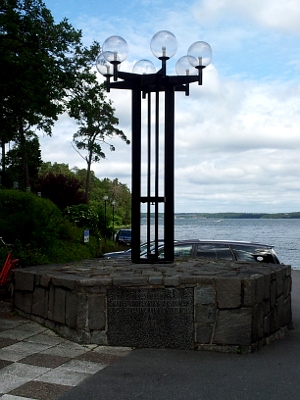Vår Gård in Saltsjöbaden is a conference venue and training centre whose history illustrates political trends in Sweden over the past century and more.
1892. The Thiel brothers, two of Sweden's wealthiest art patrons, buy a property by the sea in the new fashionable resort of Saltsjöbaden and build two luxurious summer mansions. They name the place Vår Gård, “Our Farmstead”.
1899. The Swedish Cooperative Union is founded.
1924. The Cooperative Union buys Vår Gård and adds a number of buildings to the property to house its new training centre and its art collection.
1932. Sweden's first Labour government is elected.
1944. "The Rochdale Monument", a large gate-like stone memorial by sculptor Nils Sjögren, is placed in a peripheral spot overlooking the sea at Vår Gård to mark the centennial of the founding of the world's first co-op at Rochdale in England.
1950. Mot framtiden, "Towards the Future", another sculpture by Sjögren, is erected in a dominant position at the entrance to the property. This heavy larger-than-life granite social-realist piece depicts a working-class couple and their children in a typical Stalinist / Maoist fashion, gazing steadily towards the horizon.
1976. Labour loses its first election since 1932.
The Cooperative Union has in recent years turned Vår Gård from a training centre into a commercial conference venue, hotel and spa. It's a very non-co-op place these days. And somewhere along the line – ten years ago perhaps? – they decided that a brutal granite Stalin family might not be the best representatives to welcome the businesspeople who come to Vår Gård for conferences and spa workovers. So they had the piece moved out of the way. It currently sits off to one side, hidden by trees from the sea it faces, next to a parking lot with a dumpster. Towards the Future, indeed. But the dedication plaque is still on the original plinth at the entryway, suggesting confusingly that what the Cooperative Union erected there in 1950 was an ornate lamp post.
This kind of life history for a piece of sculpture is a post-modern archaeologist's wet dream. And me? Though I admire Sjögren's technique, I think it's a pretty damn ugly piece of work.



Looking at the statue makes me think of an old joke.
Ivan got a new job and tells his friend about it: "All I have to do is stand on a high tower and look out for the world revolution, I get 50 ruble for that." His friend comments:"50 ruble, that doesn't sound like much for such an important job". "True, but it's a life time position".
Haha! Or the one about the Party strip club that hardly attracted any guests.
"Could there be something wrong with the strippers?"
"Certainly not, they all have the best qualifications, Party members since several decades all of them!"
Slightly OT, comparison Scandinavia / USA about student loan debt http://dangerousminds.net/comments/when_is_enough_going_to_be_enough_fo…
-It seems to me the best monument you can make is building a better future for your children!!!
(OT again) Martin, the Chinese are showing off!
"Pottery 20,000 years old found in a Chinese cave" http://phys.org/news/2012-06-pottery-years-chinese-cave.html
Ah, Vår Gård!
I spent a fair bit of time there as a kid since my father was involved with the (constant) restorations and renewals of the buildings in the complex.
And then later as a pimply youth (15, I believe) when I spent a summer as a demolition worker at one such project. I've run a couple of hundred wheelbarrows loaded with debris just past the statue, as it was still standing on the plinth and we used that as a ramp to reach the trash container.
That job netted me the money to buy my first portable CD player and get started on my own record collection.
Is it just me finding it a bit weird that the parents are dressed and the kids are nude in that sculpture? Wonder if some symbolism was intended or if it just shows how times have changed? If all four had been nude I would have found it a quite normal artwork, but this differentiation of adults and kids makes me a bit confused. Maybe some art historian can tell if this was a common thing at that time?
I also find that odd. And so is the drooping doll the girl is holding!